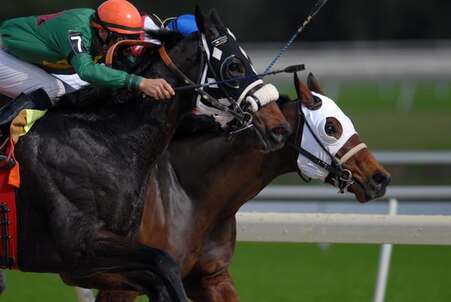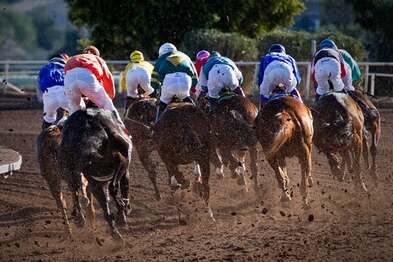 Every industry has been touched by the effects of the current worldwide pandemic. The world of horses and horse racing has been no stranger to these impacts. Since the pandemic shut the world down in February and March, every industry has felt those reverberations. Quickly gaining on six months of this strange new world here in the Lowcountry, we too have felt the world shifting. We have changed our policies and what services are available to our riders and guests to keep everyone safe and healthy. When the nation started closing down and canceling major events, it was no surprise that horse tracks and horse races started to shut down and cancel in the footsteps of the NBA, NFL, MLB, and the PGA. Every industry has felt the shock waves of these effects, and all of us at home have felt the tremendous loss these decisions have caused. Out of the safety of our nation and its people, we recognize the importance of these decisions, but there is plenty still left to mourn. What should come as a surprise is that even though it drastically changed, the industry of horse racing didn't actually shut down. In a recent interview, racing analyst Randy Moss mentioned that even though the world has changed and we've adapted to an online world, the world of horse racing can't be stopped. He said, "You can't water or feed horses through Zoom. They can't get veterinary care through Zoom!" So, those behind the scenes, almost 1500 people to every 1000 horses at each American race track according to Moss, have kept the industry afloat. The needs of these living and breathing creatures depended on quick action, which is exactly what happened. Decisions were made to keep both the industry and the industries employees alive and well. This doesn't mean that every race and event went on as normal. Once things started to shut down it was almost like a domino effect, and it was felt globally.
One of the largest blows our industry saw was the postponement of the Kentucky Derby. For the first time since 1945, it was pushed back to a different date. After weeks and months of waiting, Churchill Downs announced that the race was going to be moved to September 5th. With this change, the entire set up of the Triple Crown was completely changed. For the first time in its 152 years, the Belmont Stakes started the Triple Crown instead of ending it. On July 20th, the race still went on as planned. Here too, no fans were present. Tiz The Law took first. The hope that the Kentucky Derby would be able to have fans in the stadium was still in the works when the date was pushed back. Many believed that by September, things would be looking much different. During June and early July of this year, it was announced that 14% of the Derby's capacity would be allowed to attend in person. Social distancing and masks along with frequent hand washing and sanitizing were going to be strongly suggested. Whether masks were going to be enforced or not was never solidified, according to CBS news. This decision and the uncertainty of masks were met with skepticism. As weeks went on and the spike in Coronavirus cases went up drastically, the executives of Churchill Downs decided to change their minds. According to CNN, the race will still be run, but without a crowd. The 14% capacity was still 23,000 fans, and that was too much for comfort. Kentucky governor, Andy Beshear, has praised the decision according to CNN. Although it is a tragic disappointment and loss, it is understood. Following the Kentucky Derby will be the Preakness Stakes on October 3rd, officially finishing the Triple Crown of 2020. The derby was one of the last big sporting events to see such a change. 2020 has been a huge blow to every industry and sports lovers alike. Throughout Europe, with pandemic numbers looking more promising, they are hopeful for races that were postponed to the fall. Many of these races will be run much later than they ever have been before. They hope that by pushing them back they will be able to amp up even more excitement and be able to have some, even if it is limited, crowd engagement. What has 2020 done to your connection to the world of horses? Comment below - we want to hear from you! Until next time, stay safe and stay hopeful.
0 Comments
 It was such a joy to walk down the honored halls of some of the most famous horses of all time that we couldn't just limit it to one blog. It was hard enough to pick just a handful to celebrate, but it's been such fun to comb through their history and share their stories with you! Happy November, Friends! Have you stopped by to enjoy the cool weather and beautiful foliage on our riding trails yet? It's starting to get chilly - so make sure you come to see us soon! While you are waiting for your next ride, we wanted to continue our history lesson with some of the most famous horses of all time. We are moving forward with Seabiscuit and Seattle Slew! SEABISCUIT This amazing horse was the grandson of Man O' War, one of the horses we discussed in our last blog. Ironically, Seabiscuit didn't show any racing qualities until later in life and was on the smaller side. He was born in Lexington Kentucky on May 23, 1933. Just two years later he made his racing debut at Hialeah Park in Florida on January 19, 1935. Thankfully he was purchased by Charles S. Howard after his first few unsuccessful racing seasons. He lost 17 races in a row before Howard found him with trainer Tom Smith. They found Seabiscuit 200 pounds underweight, exhausted, and in a terrible temperament. He needed rest, relaxation, and to heal before anyone raced him again. That's exactly what Smith gave him, and he came out of his vacation a brand new horse. With the help of Smith and his jockey Red Pollard, Seabiscuit won 11 of the 15 races he entered in 1937. Pollard was a bit of a controversial jockey. He was much bigger than most and was blind in one eye. But both underdogs took to one another right away, and the pair became famous virtually overnight. His popularity soared during the Great Depression and gave the country something to hang on to. He was named Horse of The Year in 1938 and was the champion handicap horse in 1937 and 1938. One of his crowning moments, known as the "Match of the Century", was when he defeated Warm Admiral in 1939 at the Pimlico Race Course in Baltimore, Maryland. War Admiral was considered the fastest horse of his time, and no one saw this race turning out the way it did. Seabiscuit retired in 1940 and went on to inspire many books, movies, and a major motion picture in 2003 with Toby McGuire, Chris Cooper, and a full star-studded cast. In his six racing seasons, Seabiscuit won 33 of his 89 races with a total winning of $437,730. At the time this was a record for an American Thoroughbred. Just a few days shy of his 14th birthday, Seabiscuit died of a heart attack and is buried at Ridgewood Ranch in California. SEATTLE SLEW This stunning horse was born on February 15, 1974. His owners were Mickey and Karen Taylor and Jim Hill of Tayhill Stable. His parents were Bold Reasoning and poker mare, My Charmer. No one expected much from Slew when he was born, but thankfully someone gave him a chance. The moment he hit the race track, he was a born runner. When Slew was born he was described as ugly, He was an almost all-black bay, something that didn't catch the eye. He had big floppy ears and a very big personality. He was big for his age, and very clumsy when he first started. He needed time to grow into his body, and to learn how to become the powerhouse he was destined to be. He was bought by Tayhill Stable at a steal of $17,500 in 1975. He was then trained by Bill Turner, and under his tutelage Slew learned quickly and had great confidence in his skills. At three years old he made his career debut with jockey Jean Cruguet, who helped him make a 5 length victory at Belmont Park on September 20th, 1977. He went on to win the Triple Crown that same year. Slew was the 10th Triple Crown winner for the United States and the first to complete the series with an undefeated career record. Through his career years between 1976 and 1978, his total earnings were $1,208,726. He had 17 starts, 14 first place wins, and 2 second place wins. Just two months before he was set to retire he defeated the heir to the Triple Crown, Affirmed, in the Grade 1 Marlboro Cup at Belmont Park. After he retired, he sired more than 100 stake winners. He was the only stakes winner to sire a Belmont winner, A.P. Indy, who also sired a Belmont winner, Rags to Riches. At the tender age of 28, Slew passed away 25 years to the day he won the Kentucky Derby. These amazing horses have such inspiring stories to tell. We are inspired by them daily and the legacy they have left behind. We have loved walking down memory lane with you and look forward to the next time we meet. See you at the stables!  Just like any Hall of Fame, horse lovers can easily name off some of their favorite famous horses of all time. In this two-part blog post, we will be talking about some of the most famous horses of all time and why they changed the world of horse racing as we know it. Horse lovers through time, no matter their age or background, can name off some of the most famous and important horses of all time. Each one of them will have their own opinions on why they believe their top four or five took those places. But there are a few who always make the top ten list. These beautiful creatures helped change history, shaped the country when they were needed the most, and gave people something to celebrate in desperate times throughout history itself. Even if you've never ridden a horse, we are sure that you could name at least one famous horse. We are going to be celebrating some of these incredible animals and celebrate their legacies!
His owner, Samuel Riddle, was a very private man, and almost decided not to race him. His career was cut short after just three incredible years, and his owner didn't allow him to race in longer events. This included the Kentucky Derby and the other famous races that if he would have won, made up what became known as the Triple Crown. Even still, he established three world records, two American records, and seven track records. He was the Preakness Stakes and Belmont Stakes champion in 1920 and defeated the 1919 Triple Crown winner, Sir Barton, by 7 lengths in 1920. In his whole career, Man O' War lost just one race at the Sandford Memorial Stakes but still came in second. It was a story that haunted his whole career and the rest of his life. He was so popular during his race years, that everywhere he went he had an armed guard protecting him. After he retired into sire life, he produced over 64 stake winners and 200 champions. One of his offspring sired Seabiscuit, who we will be talking about in our next blog! His total record earnings when his career came to an end was $249,465. Which during a time of war, was pretty incredible. After his death, he laid in state for several days as thousands came to pay their respects to the incredible horse. He is now buried at the Kentucky Horse Park. Who is your favorite famous horse of all time? We still have a few more horses to introduce you to, but those will have to wait until next time! |
AuthorMiddleton Place Team Archives
January 2021
Categories
All
|
|
4280 Ashley River Road, Charleston, SC 29414
[email protected] 843-735-0709 Please also visit: Middleton Place | The Inn at Middleton Place |
Site powered by MadeSimply
|
 RSS Feed
RSS Feed

